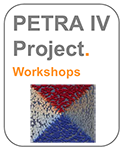Speaker
Dr
Peter Gaal
(Institute for Nanostructure and Solid State Physics)
Description
We employ femtosecond transient grating (TG) spectroscopy to generate and control thermally induced surface deformations. Our sample consists of 60nm Stronthium Titanate on 150 nm Stronthium Ruthenate which is grown on Dysprosium Scandate substrate. We excite the sample with a commercial Titan:Sapphir laser amplifier. The transient grating is generated by imaging a transmission phase mask onto the surface of the sample with the femtosecond laser puls. The optically induced periodic surface distortion, which results from absorption of the excitation laser in Stronthium Ruthenate, allows for in-plane momentum transfer to an incident hard x-ray beam. Thus x-ray photons scatter into high orders of the surface phase grating. We present measurements of the time-dependent dynamics at the surface. The distortion can be decomposed into a thermal background and coherent surface acoustic waves. Based on our data we developped a diffraction model which predicts a peak diffraction efficiency of 33% into the first order of the surface grating. The incoherent thermal background is the main contribution to the surface distortion. By employing a second TG excitation, we perform spatio-temporal cohernt control of diffraction from the surface. We demonstrate enhancment and complete suppression of diffraction from the surface by changing the temporal and spatial overlap between multiple TG excitations. This flexible experimental scheme allows for spanning variable temporal gates for hard x-ray pulses.
Author
Dr
Peter Gaal
(Institute for Nanostructure and Solid State Physics)
Co-authors
Dr
Marc Herzog
(Universität Potsdam)
Mr
Mathias Sander
(Universität Potsdam)
Dr
Vasily Temnov
(IMMM CNRS 6283, Universit´e du Maine, 72085 Le Mans cedex, France)

